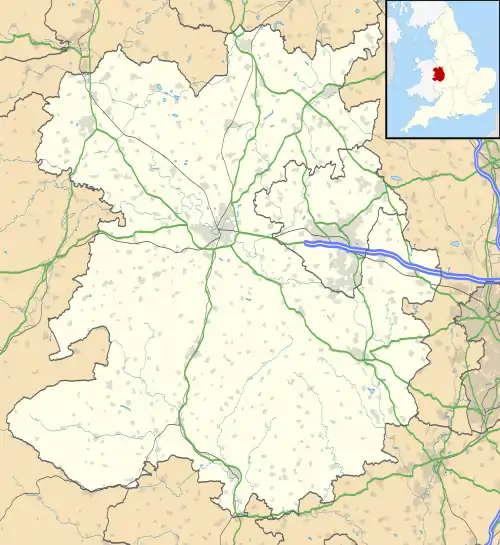Old Oswestry
Old Oswestry is a large early Iron Age hill fort in the Welsh Marches near Oswestry in north west Shropshire. The earthworks, which remain one of the best preserved hill forts in the UK, have been described as "The Stonehenge of the Iron Age Period". After the hill fort was abandoned, it was incorporated into Wat's Dyke by the Mercians during the Early Medieval period.[1]
.jpg.webp) An easterly view of the western entrance to Old Oswestry hill fort | |
 Location of Old Oswestry Hill Fort within Shropshire | |
| Location | Oswestry, Shropshire |
|---|---|
| Region | West Midlands |
| Coordinates | 52.87273°N 3.04886°W |
| Altitude | 165 m (541 ft) |
| Type | Hillfort |
| Area | 25 ha (62 acres) |
| Diameter | 500 m (550 yd) |
| Circumference | 1,600 yd (1,500 m) |
| Height | 27 m (89 ft) |
| History | |
| Material | earth and wood |
| Founded | 8th century BCE |
| Abandoned | Roman conquest of Britain |
| Periods | Iron Age Roman Britain |
| Cultures | Celtic people of Iron Age Britain |
| Associated with | Cornovii or Ordovices |
| Site notes | |
| Excavation dates | 1939 |
| Archaeologists | William J Varley |
| Management | English Heritage |
| Public access | free |
The hill fort was designated as a scheduled monument (number 27556) in 1934. The site is now managed by English Heritage. The accessible hill fort gives panoramic views across North and Mid Wales, Cheshire and Shropshire.
History
The earliest occupation of the site began in the 8th century BC and continued up until the Roman conquest of Britain. Its inhabitants were either from the tribes of the Cornovii or Ordovices.[1][2]
The complexity of defences suggests there have been several phases of development. In the earliest period, a few round huts were sited on the undefended hillock. Subsequently these were enclosed by a double bank and ditch that enclosed 5.3 ha (13 acres). Entrances were placed at the east and west ends of the earthworks where the inner bank was pulled inwards to create large gateways. Later a third bank was added on all sides except the south east where the hill's steep incline made it unnecessary.
The western entrance was re-modeled with unusual rectangular hollows separated by ridges dug out and defended by outworks. The eastern entrance was also strengthened with two further external circuits of banks and ditches.[1] Despite the size of its fortifications, there is no evidence that the Roman Legions attacked Old Oswestry during their conquest of the region in the 50 CEs.[1]
In the Early Medieval period, it became associated as the birthplace of the ancient Brythonic queen "Ganhumara"; Guinevere of Arthurian legend.[3]
During the First World War, the Canadian Expeditionary Force stationed at nearby Park Hall camp used the earthworks for training purposes. Many large pits, trenches and craters from explosives irreparably damaged the interior site during these military activities.[1] The war poet Wilfred Owen, who was born in Oswestry, completed his army training at the Park Hall camp which used the hill fort for trench warfare training.
Preservation
In 1939, Yorkshire geologist and amateur archaeologist William J Varley conducted the most extensive examination of the site.[4] His work, which was not published until the 1990s, remains the most authoritative work on the site. His excavations showed that the complex defensive ramparts that surround the hill fort were not built at the same time and that there were four distinct phases in their development.
The hill fort is now managed by English Heritage. Access is free.
Since 2015, housing developers have been trying to get planning permission for new homes near the slopes of the ancient monument. However, an ongoing campaign (backed by local residents and archaeologists) has stalled these proposals.[5]
References
- "History of Old Oswestry Hill Fort". English Heritage.
- "OLD OSWESTRY HILLFORT". Historic England.
- "Hill fort said to be where King Arthur's Guinevere was born has lasted 3,000 years: now it's under siege". www.theguardian.com. 27 June 2015.
- "Castle Hill, Almondbury". huddersfield.exposed. Retrieved 26 December 2018.
- "Fresh application lodged for homes near Old Oswestry Hillfort". Shropshire Star. 14 August 2018.
External links
| Wikimedia Commons has media related to Old Oswestry Hillfort. |